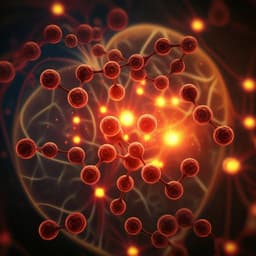
Biology
Binary vector copy number engineering improves *Agrobacterium*-mediated transformation
M. J. Szarzanowicz, L. M. Waldburger, et al.
Discover how a team of researchers, including Matthew J. Szarzanowicz and Lucas M. Waldburger, has revolutionized plasmid functionality by enhancing *Agrobacterium*-mediated transformation (AMT) efficiency! Through innovative directed evolution, they've identified mutations that significantly boost transformation rates in various organisms. This groundbreaking framework opens new avenues for precision in prokaryotic genetic engineering.
Playback language: English
Introduction
Agrobacterium-mediated transformation (AMT) is a crucial tool in plant and fungal biotechnology, enabling the insertion of transgenes into target cells. This process exploits the natural DNA transfer capabilities of *Agrobacterium tumefaciens*, replacing its oncogenic genes with user-defined sequences. Early improvements to AMT involved transferring the left and right border (LB and RB) sequences from the large tumor-inducing (Ti) plasmid to a smaller binary vector. DNA between the LB and RB is transferred as T-DNA and integrated into the target cells, facilitated by virulence (*vir*) genes in the Ti plasmid. The ease of modifying the transgene by altering the sequence between the LB and RB has solidified AMT's role in agricultural biotechnology, bioenergy crop engineering, and synthetic biology. Despite AMT's transformative impact, transformation efficiency remains a major bottleneck, particularly in many plant species. While decades of optimization have improved AMT through adjusted induction conditions, *A. tumefaciens* strains, and enhancements to *vir* gene expression, efficiencies remain low. Some protocols employ ternary vectors that overexpress virulence genes, but overall improvements are still needed. This limitation highlights the need for improved tools to control and enhance the AMT process. Relatively little work has focused on engineering the binary vector backbone itself. The origin of replication (ORI) within binary vectors dictates both host range and copy number and impacts AMT efficiency. Previous studies have indicated a correlation between binary vector copy number and transformation efficiency, yet they haven't systematically modified this variable across diverse ORIs. There is existing evidence that different ORI copy numbers influence AMT efficiency, but no previous attempts have systematically modified this variable for binary vectors. To address this gap, the researchers aimed to develop a method to systematically select for higher-copy-number mutants across diverse ORIs, improving AMT efficiency across kingdoms.
Literature Review
Existing literature highlights the importance of plasmid copy number in prokaryotic synthetic biology, impacting engineered metabolic pathways and synthetic circuits. Previous work has focused on engineering plasmid copy number in narrow-host-range origins (e.g., pMB1 and pSC101 derivatives) in *E. coli*. However, for broad-host-range ORIs used in *A. tumefaciens*, such engineering efforts have been limited. Studies have shown a correlation between binary vector copy number and AMT efficiency, with higher copy numbers potentially leading to increased transformation efficiency. However, these studies compared different ORIs, not copy number variants within the same ORI, making it difficult to isolate the impact of copy number. One study evaluated a single higher-copy-number mutant of the pRi ORI and found no improvement. The authors highlighted the lack of a generally applicable method for systematically screening copy number diversity across various ORIs and called for a more comprehensive screen. This review of the literature established the need for a high-throughput screen to identify and characterize numerous copy number variants to assess the impact of plasmid copy number across multiple broad-host-range ORIs used for AMT.
Methodology
The researchers developed a high-throughput growth-coupled selection assay combined with directed evolution to identify ORI mutations that influence copy number and improve AMT efficiency. They focused on four broad-host-range origins (RK2, pVS1, pSa, and BBR1) commonly used in *Agrobacterium* and prokaryotic biotechnology. The entire *repA* open reading frame (ORF) for each ORI was randomly mutagenized using error-prone PCR (epPCR), generating mutant libraries. A directed evolution assay coupled plasmid copy number to bacterial antibiotic tolerance. The assay used a selection vector with a gentamicin resistance gene driven by a salicylic-acid-inducible promoter. This survival-coupled selection enriched higher-copy-number mutants. Whole-population sequencing (Illumina MiSeq) was used to quantify mutant enrichment at every RepA residue, identifying residues associated with higher copy numbers. Selected residues were cloned into plant expression binary vectors (constitutive plant promoter driving GFP), creating vectors differing by a single SNP in *repA*. These vectors were transformed into *A. tumefaciens* (EHA105 strain) and screened in a transient expression assay in *N. benthamiana*. Digital PCR (dPCR) was used to quantify plasmid copy number, and a time-course plate growth assay determined *A. tumefaciens* growth rates. Stable transformation experiments in *A. thaliana* (floral dip method) and *R. toruloides* were conducted to evaluate the translation of transient expression results to stable systems. The study included detailed methods for media preparation, culture conditions, strain and plasmid information, epPCR mutagenesis, library construction, selection of higher-copy-number mutants, sequencing, plant vector construction, transient expression screening, copy number quantification, growth rate quantification, *A. thaliana* transformation, and *R. toruloides* transformation. The specific primers, software, and kits used are meticulously listed.
Key Findings
The directed evolution pipeline successfully generated copy number variants for four diverse ORIs. Transient expression assays in *N. benthamiana* revealed that mutants for all four ORIs significantly increased GFP output compared to wild-type (WT) forms, with pSa showing the largest fold-change increase (6.9-fold). dPCR analysis revealed varying relationships between copy number, growth rate, and AMT efficiency among the four ORIs. pSa showed a direct relationship between copy number and GFP output; increased copy number correlated with increased GFP expression. RK2 exhibited an optimal copy number range (5–15 copies), beyond which performance declined. pVS1 showed an optimal copy number range (30-40 copies) and a negative relationship between copy number and growth rate. BBR1, surprisingly, showed no correlation between copy number and GFP output; growth rate was the primary influencing factor. Stable transformation experiments in *A. thaliana* and *R. toruloides* confirmed that the superior mutants from the transient expression screen also enhanced stable transformation efficiencies. The pVS1 R106H mutant increased *A. thaliana* stable transformation efficiency by 60–100%, while the RK2 and pSa mutants showed even more dramatic increases. In *R. toruloides*, the pVS1 and RK2 mutants improved stable transformation by 390% and 510%, respectively. Mutation fold-change enrichment in the initial screen did not strongly predict downstream AMT performance, except for pSa. The study generated a large library of copy number variants surpassing previous levels for these ORIs in other bacterial species. The researchers demonstrated that single SNPs in the binary vector backbone could vary transient expression levels significantly.
Discussion
This study successfully demonstrated that engineering binary vector ORIs improves AMT efficiency. The findings highlight the complex interplay between copy number, growth rate, and AMT performance, which varies depending on the specific ORI. The observed relationships demonstrate that increasing the copy number does not always correlate with improved AMT. The results support the notion that high copy numbers might impose metabolic burden. The effectiveness of the *N. benthamiana* transient expression screen as a predictor for stable transformation outcomes is validated by the results obtained in *A. thaliana* and *R. toruloides*. The generated library of copy number variants will be valuable for various prokaryotic engineering efforts, enabling more precise genetic control in nonmodel bacteria. The research provides a readily deployable method for enhancing downstream transformations. The study suggests future work focusing on characterizing the relationship between binary vector copy number, stable transformation efficiency, and the quality of the generated events. The use of high-copy-number mutants for gene editing, specifically to enhance HDR efficiencies, is another avenue for exploration. Further optimization might be achieved by stacking mutations and exploring different amino acid substitutions.
Conclusion
This research created a toolkit of copy number variants derived from single *repA* SNPs that effectively modulate plant transient expression levels and improve stable transformation in plant and fungal systems. This expands and refines control over AMT, offering a high-throughput strategy to engineer plasmid copy number for enhanced precision in prokaryotic genetic engineering. The generated libraries of copy number variants offer the possibility of fine-tuning T-DNA delivery and potentially improving the efficiency of gene editing through HDR. Further investigation is needed to fully characterize the relationship between copy number, transformation efficiency, and event quality across the wide range of copy number variations. Future work could include testing the efficacy of these modified plasmids in other plant and fungal systems.
Limitations
The study focused on four specific ORIs, and the findings might not be generalizable to all ORIs. The relationships between copy number, growth rate, and AMT efficiency are ORI-specific and complex, suggesting a need for empirical testing for each ORI and potential mutant. The correlation between mutation enrichment in the initial selection assay and downstream AMT performance is weak, except for pSa, indicating that the assay's predictive power may be limited.
Related Publications
Explore these studies to deepen your understanding of the subject.







